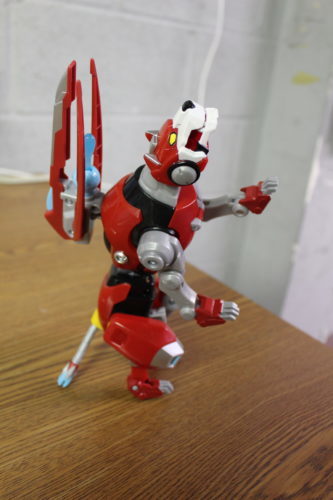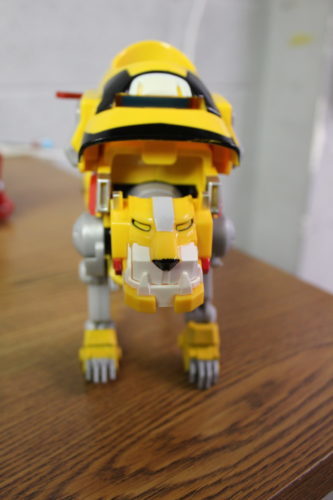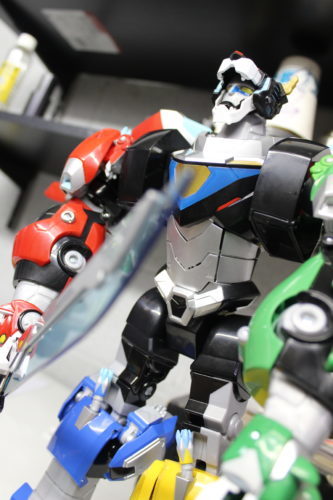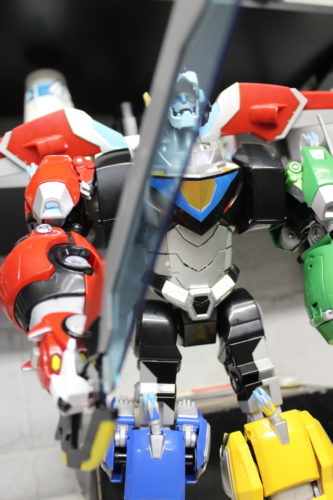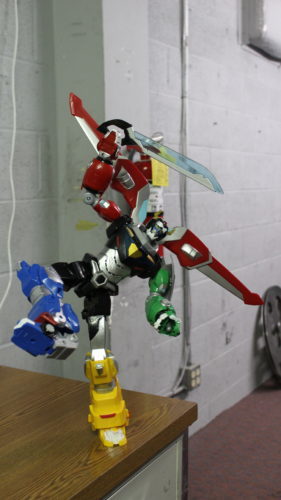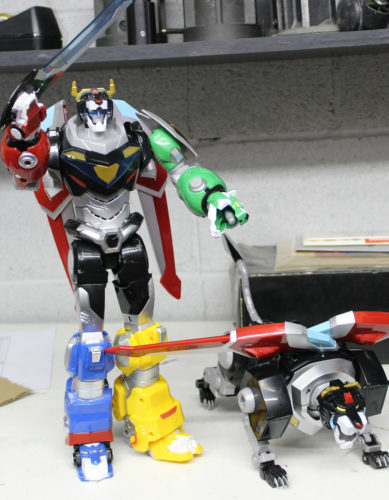Chris Hardwick's Blog, page 2186
January 27, 2017
STRANGER THINGS’ Millie Bobby Brown Joins GODZILLA Sequel
Everybody’s favorite Stranger Things actor, Millie Bobby Brown (sorry Winona, we still Godzilla: King Of Monsters, the followup to Legendary’ 2014 Kaiju feature Godzilla. Michael Dougherty (Krampus) is directing the new project, which is expected to hit theaters on March 22, 2019.

Titled officially as Godzilla: King of Monsters, the film will incorporate the forthcoming Kong: Skull Island and is set to kickstart Legendary’s new cinematic universe with iconically large monsters from films of old. Given that Millie Bobby Brown single handedly defeated the Demogorgon with her mind (!!) in the first season of Stranger Things, we have a feeling that the young actress will kick some serious butt in the new creature feature, with or without Bryan Cranston, Aaron Taylor-Johnson, and Elizabeth Olsen (the stars of the 2014 Gareth Edwards reboot film, for those of you not in the know. We’re here to be service-y, y’all!).
Something tells us all she’d have to do is walk up to Godzilla like:

…and he might run away scared. As he should. BECAUSE SHE’S ELEVEN.
Any ideas about how Bobby Brown will factor into Godzilla: King of the Monsters? It may be a bit early to speculate, but that has never stopped us before. Let us know your thoughts in the comments.
And since we’re talkin’ Millie, why not check out what the season two hints mean for Stranger Things’ next installment:
Editor’s Note: Nerdist Industries is a subsidiary of Legendary Digital Networks.
Images: Netflix
Audio Rewind: How Kraftwerk Changed Music Forever
Any discussion of the most era-defining, paradigm-shifting figures in contemporary music would be incomplete without Kraftwerk. The German krautrock band was the first act to popularize electronic music, and if you’ve listened to any piece of music in the new millennium, you’ve likely borne witness to the near-profligate dissemination of electronic sounds. Much to the chagrin of dogmatic roots rock and folk lovers, electronics are here to stay—and all for the better, I think! Art should be driven to challenge its audiences; envelope pushing doesn’t detract from any of the existing styles, it simply adds another color to the palette. And would we have that without Kraftwerk? Almost certainly not. They’re so integral to the fabric of music culture that, three years ago this week, they received a Lifetime Achievement Grammy in the same year it was given to a band called the Beatles. That alone should speak to the essentialism of their craft and the work that they’ve put forth. This is Kraftwerk.
In the late ’60s, Florian Schneider (flutes, synthesizers, violin) and Ralf Hütter (organ, synthesizers) met as students at the Robert Schumann Hochschule in Düsseldorf. They were already active participants in the incipient German experimental scene—then still a fringe arena with next to no gravity. Soon, though, they would help conceive a genre that challenged its obscurity.
Krautrock, (or komische music, aka cosmic music), is a combination of psychedelic rock, avant-garde electronica, funk, minimalism, jazz, world music, improvisation…basically, it’s anything goes. At that time, ‘kraut’ was a derogative word for both German soldiers in the World Wars and drugs. “Krautrock,” coined by English-speaking journalists in Melody Maker magazine, was a pejorative epithet for these beastly combinations of sounds. Beastly, at least, until krautrock exceeded expectations, attracted an audience, and became popular in Europe’s music mecca: Britain.
Kraftwerk, of course, were krautrock trailblazers. Trails don’t just blaze overnight, though. The band’s first three albums were freeform explorations that depicted the band’s search for footing. The first two, Kraftwerk and Kraftwerk II, were entirely instrumental, pairing real instruments with simple electronics like audio tape manipulations and beat-box drum machines. But the third, Ralf unt Florian, captures on tape the shaping of the iconic Kraftwerk sound. Heavier synths and drum machines bore more conviction as they settled into their groove. Another, even more integral addition to the record was the vocoder, the signature of the Kraftwerk legacy.
Kraftwerk popularized the vocoder, which was initially used as a military tool for scrambling voice IDs, as a musical instrument (though there is some contention about who first used the vocoder as an instrument, an argument you can see in the New Yorker’s excellent video below). Through the digitized mechanism, Kraftwerk relayed robotic lyrics about post-war Europe, technology, and urban life—each item electric in its own way.
Subsequent albums, Autobahn (1974) and Radio-Activity (1975), were accompanied by equipment upgrades and a cleaner sound. The crisp vibe of the latter LP won them an international audience—the album peaked at No. 5 on the Billboard 200. Amongst their new fan base was none other than David Bowie. After hearing Radio-Activity, Starman invited the band to tour with him in support of Station to Station. Kraftwerk declined, though, and despite repeated rumors of collaboration, one never came to fruition. Still, the band continued to impress Bowie, and their style was one of the most notable influences on his storied, Brian Eno-produced Berlin trilogy.
At this point in their run, the famous Kling Klang studio was operating at full capacity. The studio was a secret place that was both holistic musical instrument and sound lab—a reflection of the Bauhaus aesthetic that inspired the band’s style. Throughout their career, the band would continue to upgrade Kling Klang, buying new equipment, making their own, and even converting some of their instruments to hand-held controllers. Eventually it was so optimized that it became portable. After the arrival of Computer World (1981), the studio was brought on tour and implemented into live performance. The vocoder was given a larger role and, to better reflect their mechanistic sound, Kraftwerk replaced themselves on stage with mannequin replicas—typically for their hit song, “The Robots.”
Two years later, after recording the single “Tour de France,” Hütter was involved in a serious bicycling accident and went into a coma. He would recover but, following the band’s 1986 record, Electric Café, Kraftwerk became a less stable group. Their lineup would become increasingly variable over the next several years and they wouldn’t release any new material until 2003’s Tour de France Soundtracks.
By then, Kraftwerk was already a legend whose influence was readily palpable. Depeche Mode, Aphex Twin, Bjork, Daft Punk, Prodigy, Joy Division/New Order, Blondie, and LCD Soundsystem are amongst the hundreds of artists that cite Kraftwerk as a major influence. Each of these artists, in turn, have become seminal influences for generations of artists. Moreover, the Kraftwerk sound helped shape New York’s electro movement (Afrika Bambaataa) and, in Detroit, their melodies were fused with funk rhythms to form techno. The far-reaching applications of their music is extraordinary; it’s difficult to imagine a world without any of these things in it.
Perhaps most salient about Kraftwerk’s style was that it marked a divergence from the canonized and much revered blues-rock genre. In discovering their sound, the band merged loose ends—those strands of erudite experimentalism, errant noise, and other niche styles—and then consolidated them into a more accessible package. Kraftwerk shed light on the avant-garde without abandoning the lay listener, and that is probably their hallmark achievement. It’s certainly one of the primary reasons they’re so celebrated. The Observer once wrote that “no other band since the Beatles has given so much to pop culture.” And NME went one step further, declaring that the Beatles and Kraftwerk exist on equal footing, sharing the title of most important band in music history.
It’s fitting, then, that the two acts should have been honored on the same day. For as much as music owes the Beatles, perhaps even more is owed to Kraftwerk, because the implications of their pioneering spirit are tangible still today. All around the world, producers, beat-makers, would-be robots, and cosmic sound enthusiasts continue to plumb music’s outer regions. Defining eras. Shifting paradigms. Painstakingly molding their craft.
Image: Andriy Makukha
Cosplay Friday #197 – DOCTOR WHO Meets STAR WARS and More Costumes by Sterling Arts and Design
What kind of Doctor would Boba Fett be? Cosplayer Christian Hegg, a.k.a. Sterling Arts and Design, has me pondering that all important question today. He has a costume that mashes together Star Wars and Doctor Who, and I have no problem picturing the bounty hunter traveling through time and space. Of course, he lacks the compassion of the Doctor–that’s a minor problem. But he does have the look down:

Whoba Fett (Star Wars and Doctor Who) | Photo by 16 Degrees Studio
I am all about the public call box helmet.
Whoba Fett isn’t the only Fett in this post. Use your jetpack to fly to the gallery and see a Disco Fett; you’ll also find a gender-bent Ramona Flowers from Scott Pilgrim, a Marvel and Super Mario Bros. mash-up, and more. See more of Christian’s costumes by liking his Facebook page and following him on Instagram.
Do you cosplay or take photographs of cosplayers? Then I want to see your work so we can talk about highlighting your creations in a future Cosplay Friday gallery. If you’re interested, please get in touch with me at alratcliffe@yahoo.com and send hi-res photos you’d like me to feature. Be sure to provide credits for the cosplayers or photographers for each image, because giving credit is good manners–bonus points if you include links to relevant Facebook pages or websites. Though I wish I knew all the geek franchises, I don’t, so please let me know who or what is being cosplayed.
Images: 16 Degrees Studio, courtesy of Christian Hegg
GAME OF THRONES Re-Throned: “Mhysa” (S3, E10)
Winter is coming, but not soon enough. So to help pass the time until season seven of Game of Thrones, we’re doing a weekly re-watch of the series, episode-by-episode, with the knowledge of what’s to come and—therefore—more information about the unrevealed rich history of events that took place long before the story began. Be warned, though: that means this series is full of spoilers for every season, even beyond the episode itself. So if you haven’t watched all of the show yet immediately get on that and then come back and join us for Game of Thrones Re-Throned.
Because the next best thing to watching new episodes is re-watching old ones.
——
Season 3, Episode 10: “Mhysa”
Original Air Date: June 9th, 2013
Director: David Nutter
Written by: David Benioff and D.B. Weiss
There’s no way to sugarcoat just how embarrassing the final shot of this season is, the sequence that gives the episode it’s name, “Mhysa.” The blonde foreign white lady comes to the rescue of a helpless group made up almost entirely of people of color, and they are so grateful to her they call her “Mother” and lift her up like a deity, all while she soaks in the adoration.

You can understand the intention behind the scene, and how the logistics of filming in a foreign land and needing a huge group of extras dictated the optics, but it just doesn’t work—at all. Even Jorah was uncomfortable watching it.

Fortunately the rest of the season three finale is full of great, important (and telling) moments, so much so that we’re going with bullet points to talk about them all.
Tyrion Threatens Joffrey—Again: We know he didn’t do it, and his trial was a sham, but you can’t really blame Cersei for thinking Tyrion was the one who killed Joffrey. He did consistently threaten to maim or murder his nephew for years, like he did here when Joffrey said he was going to serve Robb’s head to Sansa. That led to an argument between the two over how Tyrion’s new wife would be treated, and it ended with this line from Tyrion to Joffrey.
“Oh, I’m a monster. Perhaps you should speak to me more softly then. Monsters are dangerous and just now kings are dying like flies.”

Joffrey would be poisoned shortly after at his own wedding—where Tyrion just so happened to be acting as his cup bearer. I mean, seven hells Tyrion should have been found guilty.
Tywin Once More Suggests Tyrion Might Not Be His Son: Following a conversation about how the North will remember what Tywin did at the Red Wedding (spoiler alert: the North pretty much forgets), the two talk about duty and family, with Tywin again talking about how everything is done for House Lannister, even making the Lannister children miserable.

Tyrion asks him, “When have you ever done something that wasn’t in your interest, but solely for the benefit of the family?” It’s a great, fair question, but Tywin’s response might answer another question that we have.
“The day that you were born. I wanted to carry you into the sea and let the waves wash you away. Instead, I let you live. And I brought you up as my son. Because you’re a Lannister.”
Much of what Tywin has said to Tyrion before about him not being worthy of being his son—and this is surely how Tyrion hears it—could be chalked up to Tyrion being a dwarf and the same Tywin feels because of that. However, when he says, “And I brought you up as my son,” it sounds like Tyrion really isn’t his son, but admitting so would have brought tremendous shame to the family and to his beloved wife Joanna who passed away during Tyrion’s birth.
It’s just so weird to phrase it that way (in a private conversation especially), and it makes the fan theory that Tywin’s wife was raped by the Mad King, and Tyrion is really his son, feel like one of the biggest secrets we have yet to learn.

Don’t forget Tywin’s last words on earth, after Tyrion shoots him with the crossbow: “You’re no son of mine.”
Bran Predicts Walder Frey’s Death: Sitting in the supposedly haunted Nightfort along the Wall, Bran tells the story of the Rat Cook, who killed a king’s son and then fed the boy to his father in a pie. For this he was then turned into a giant rat by the gods, not for the murder or the pie, but for harming someone in his own home that he had sworn to protect. The show brilliantly goes from that story to a shot of Walder Frey gloating over the Red Wedding.

Arya’s revenge years later, when she fed Lord Frey’s sons to him in a meat pie before slitting his throat, was beautifully foreshadowed here.
Though admittedly “beautifully” is a weird way to describe all of this.
Jojen Hints At Who Can Defeat the White Walkers: After meeting a fleeing Sam and Gilly, Bran says they have to go beyond the Wall, but Sam tells them if they saw what he saw they wouldn’t. Jojen already knows about the White Walkers though, and says they must go, because “the Night’s Watch can’t stop them,” nor can “the kings of Westeros and all their armies.”

That obviously suggests Bran might be the savior the living needs, but it does leave the door open for a queen, preferably one with dragons, to come to the rescue. But does this hint at a sad end for new King in the North and former Lord Commander of the Night’s Watch, Jon? Well, it’s not good.
Cersei Is Even More Dangerous Than We Realize: Blowing up hundreds of people in Baelor’s Sept might have been about survival, but with all of her children now being dead Cersei not only has nothing to live for besides revenge, she has nothing to lose because she doesn’t care if she dies.
In discussing her lack of happiness with Tyrion, she says, “But if it weren’t for my children, I’d have thrown myself from the highest window in the Red Keep. They’re the reason I’m alive.”

The Mad King thought he’d be reborn as a dragon if he engulfed King’s Landing in wildfire. Vengeful Cersei certainly has no such illusions, and would seemingly welcome death now after burying her three children. Which means not only might she be the single most dangerous person alive, she’s probably the most dangerous person to ever sit on the Iron Throne.
Arya Might be the Show’s Lady Stoneheart: What defines Lady Stoneheart? She’s a mysterious woman traveling the Riverlands, brutally killing Freys. Which is what Arya does here for the first time, when she stabs to death a Frey man she hears bragging about putting the head of Robb’s direwolf on his body. It’s graphic and super violent, and possibly a hint at what’s to come, now that she can move around anonymously with her new face-swapping skills.

Oh, and one last thing…
GENDRY GOT ON A BOAT AND DISAPPEARED FOREVER: Goodbye gentle Gendry. Go with god….s. Go with gods, old and new.

But feel free to come back this season and let us know you’re okay. Don’t worry Gendry, the guy that wanted to burn you alive is dead now anyway.
But what did you think of this episode? What about season three on the whole? Head south to the comments section below to tell us.
Images: HBO
How DEADPOOL 2’s Sillier Tone Will Shape Future X-MEN Films
This week’s Oscar nominations came and went without any recognition for Marvel’s Merc with a Mouth. Sure, the cheeky Deadpool “For Your Consideration” campaign was supposed to be a joke, but we really thought it had a shot in some categories. 20th Century Fox will just have to take consolation from the fact that Deadpool was one of 2016’s biggest blockbusters, and it easily out-performed X-Men: Apocalypse at the box office. We’re pretty sure that the studio noticed that, because today’s Nerdist News is all about Deadpool 2‘s potential impact on the next round of X-Men films!
Join host and former X-Force member, Jessica Chobot, as she looks at the latest word out of Fox regarding the future of Deadpool and the rest of the X-Men franchise. During a new interview with The Hollywood Reporter, Deadpool 2 screenwriters Rhett Reese and Paul Wernick confirmed that their corner of the X-Men cinematic universe basically gets to write its own rules. That means the Deadpool movies are a part of that world, but not really beholden to the continuity heavy approach that we’ve seen from the MCU or DC’s Extended Universe.
Naturally, Reese and Wernick touched on the potential X-Force spinoff from Deadpool before blowing our minds with this statement: “the hope is Deadpool 2, and X-Force, and future movies all be this new, consistent, sillier tone…More self-aware tone, and edgier, and Rated-R tone.”
Does that mean that even the non-Deadpool films will take that approach? Logan is already going to be Rated-R, and truthfully, the X-Men movies could really use a shift in tone. We wouldn’t say that Marvel’s mutant heroes should go full farce. But some Rated-R X-Men movies that don’t hold back on the action sounds like a great idea to us! And if the films are actually funny too, that’s a good thing.
What do you want to see from future X-Men movies? Should they follow Deadpool‘s example? Let’s discuss in the comment section below!
Boeing’s New Starliner Spacesuits Bring Refreshing Lightness to Low Gravity
Space may be cool (like -270.45 Celsius cool), but the gear astronauts have used aboard spacecraft to go to and from the International Space Station (ISS) has been not so cool. Looking at the spacesuits the Space Shuttle crew used for launch and re-entry, for example, reveals something like a onesie tailored out of a melted traffic cone. Fortunately, the new generation of brave heroes going off to the ISS in Boeing’s CST-100 Starliner Capsule will be donning suits that are lighter, bluer, and both literally and figuratively cooler than the suits they replace.

Veteran astronaut Chris Furgeson shows off the new Boeing Starliner spacesuit. Image: Boeing
Images of the new Starliner spacesuits, which come via Gizmodo and are available in more detail in the image gallery below, were recently unveiled by NASA and Boeing, and the latter emphasizes the fact that these suits are far lighter than their predecessors; to the tune of about 18 pounds according to the above clip. The suits are also cooler temperature-wise thanks to vents that allow “water vapor [to] pass out of the suit, away from the astronaut, but [still keep] air inside.” The suits also come with “touch-screen friendly” gloves, which seem like an obvious necessity considering the fact that both Boeing’s Starliner capsule and SpaceX’s Dragon capsule, have massive touchscreen displays.
The Starliner spacesuits will also only come in “Boeing Blue.”

Space Shuttle ACES suit, which was literally referred to as the “pumpkin suit.” Image: Wikimedia / NASA, Kim Shiflett
These suits will only be worn by crew members during take-off and re-entry, and will not replace the extravehicular mobility units (EMUs) that are already aboard the ISS, and used for any kind of operation that goes on outside of the ship.
As far as the Starliner capsule itself is concerned, the plan right now is to send crew members to the ISS in 2018. SpaceX, Elon Musk‘s private space company, will also be ferrying astronauts to the ISS. SpaceX also plans on debuting new suits, which will, of course, be designed in part by a genius superhero costumer.
What do you think about Boeing’s Starliner suits? Are you excited to see a new generation of spacesuits, or are you just waiting for whatever SpaceX debuts? Let us know your thoughts in the comments below!
Images: Boeing
January 26, 2017
SUPERNATURAL Recap: Winchesters Find a Way
Warning: This post contains spoilers for the Supernatural season 12 winter premiere, “First Blood.” If you haven’t watched it yet, jump into the Impala and drive away.

Freeze frame. Record scratch. You’re probably wondering how we got here… I’d pay at least a few dollars to see an episode of Supernatural open that way. Crazier things have happened on the series about the Winchester brothers, like them managing to escape from a super secret and super secure facility. Season 12 of Supernatural returned with “First Blood” on Thursday night, and of course, the Winchesters found a way.
That the Winchesters managed to escape their cells wasn’t a shock. From a practical point of view, the story has to move on. The idea of spending the next three weeks watching Dean and Sam eat unpalatable food and carve tick marks int0 the wall isn’t what I would call appealing. At the same time, it couldn’t be cake for them to get out. The solution the writers came up with to extricate the Winchesters from their predicament was clever but needed a little something.
They used a montage to establish the passage of time. Dean and Sam were in lock up for over six weeks. From the scenes and performances, it was apparent the brothers were going stir crazy. But why didn’t they try to make some Enochian or demonic or whatever symbols with their blood on the walls to summon a way out? We should have seen them try some of the tricks in their bag before they both died to escape.

Yes, died. I wondered if they managed to somehow fake death with an herb or spell, but no, Dean called upon Billie. She has to be the most patient reaper of them all. She has her limits though and made a binding deal with the brothers; she’d help them die and come back for the price of one Winchester, permanently dead. I didn’t see her role coming, and I like being surprised. Then, I fully expected Mary to sacrifice herself. Castiel’s save the day and the Winchesters action floored me.
This is when I stop focusing on the Winchesters and move on to the most consistent bright spot in the show: Castiel. He has put himself on the line for Dean and Sam more times than I can recall without looking to a fan wiki to jog my memory. But I think “First Blood” showed me a side of Castiel I haven’t seen before, and Misha Collins made it poignant.
Cass felt guilty for the Winchesters being caught. Collins did a tremendous job at conveying every nuance of despair and frustration Cass was experiencing with his facial expressions. When Castiel told Mary how he tried to do the brothers’ job and failed, Collins’ performance just about broke me. He seemed so lost. All of his emotions came to a head when Billie came to collect.

I gasped when Cass killed the reaper and almost cried when he proclaimed the world needs every Winchester it can get and he wouldn’t let anything happen to them. I’m worried about the repercussions, but at the same time, I’m moved by Cass’ extreme action. The guy knows how to make a statement.
Am I going to mention the Men of Letters before I go? I included a picture of them, so I guess I should. They’re not nice people. The end. Okay, but I can sort of see why Mary’s talking to Mick. Now I’m done. Really.
What did you think about “First Blood?” Did you see the reaper twist coming? Talk to me in the comments.
Images: The CW
Figures and Speech: VOLTRON LEGENDARY DEFENDER by Playmates
Welcome to Figures and Speech, Nerdist’s regular column by, for, and about grown-ups who still play with their toys but might want to know more before they buy. From product reviews to informed editorials, these are most definitely the articles that’ll make you want to strike a pose.
Welcome back, Voltron. The toy shelves have missed you.
The first time I ever played with Voltron, it was the Panosh Place figures made in the ’80s, and those were cool. Five lion vehicles that could actually fit Star Wars-sized figures inside, and combine to form a much larger robot, with vac-metal parts? Heckuva combo, that. I never knew the property well enough to collect the figures myself, but my cousin did, and I made sure he busted it out every time I visited. Mattel tried to revive this same toy concept a few years back via online subscription to create a 23-inch giant robot from vehicles with figure pilots, but it never seemed to really catch on, perhaps because it was a lot of cost for new tooling for a nostalgia property.
It no longer has to depend on flashbacks.
Now that Voltron is back as a Netflix show, Playmates has toys to match, so if you want to revisit those joys of building Voltron from combined lions, you can. If you’d rather just have him has one big poseable robot, you can have that too. Don’t expect Star Wars-sized figures to go inside this time, though, as these Voltrons are more to scale, and the pilot is represented on a tiny mini-speeder that fits inside the belly of each lion.
As you can see there are also no vac-metallized parts, as that’s both costly and interferes with articulation, of which the individual lion figures boast 20+ points. Let’s take a look at them–the lions, not the articulation points– individually.
At $29.99, the black lion is the most expensive, as it features a light-up V on its chest, and sounds. They seem to play in random order, so I’m not sure I heard all of them.
“Voltron is the only thing that can stop Zarkon.”
“Let’s assemble Voltron and get rid of these Galra.”
“Form…Voltron! [sounds]”
[Roar]
“We need to increase firepower!”
[Sword “ching!”]
“Systems compromised!”
[energy sound]
“Now…We will destroy you!”
“Now, we go on the offensive.”
“Let’s light this thing up. Fire lasers! [laser sound]”
“We will save the universe!”
In lion form it’s quite poseable, with fully articulated wings, neck, and legs with four joints each. His back hips are a bit limited for the benefit of the larger robot, and can’t move fully forward, but they can hinge outward. And as with every lion in this series, the belly opens for the pilot’s speeder.
The other Legendary Lions that combine with it are $17.99 each.
Articulation on the red and green lions is similar. Apart from the bits that move purely to effect the transformation, they have four joints on each leg, a mid-torso side-to-side joint that’s also a cut joint on the hind end, cut neck joints, and powerfully spring-loaded jaws. Also, they can stand up, sort of.
All of the lions come with larger weapons that plug into their backs. I think I got a bum red lion, though, because the missile in it doesn’t properly fire – it extends maybe an inch when you press the button.
The green lion’s works a lot better. Both come with parts to form Voltron’s sword, and green comes with the shield that can be swapped out for its missile launcher. There’s some paint slop on the sword, but only if you look closely.
The yellow and blue lions have less articulation, because they need to form the legs and support the whole toy. They don’t have mid-torso joints, their heads go up and down, and their front legs only have three points of articulation. But they also have robotic “manes” that move forward to cover the head in robot mode.
The yellow lion comes with the best plug-in weapon of the bunch: a disc launcher that sends its translucent blue energy frisbees clear across the length of my apartment. Blue has a similar missile launcher to the red, but it actually works.
Assembly of Voltron is straightforward – the black lion’s upper legs fold up, and lower legs fold out, its mouth opens to reveal the robot head, and the arm and feet lions plug in easily (though they may not come out so easily, especially the arms. Pulling really hard may be necessary.)
He is a little back-heavy – you may want to lean him forward a bit, or just always pose him with arms outstretched wielding the sword.
The key gimmick, and it’s a fancy one, is that once all the lions are plugged in, new sounds are activated. The existing commands from the black lion play, but they often get a reply, and it can be at random. Like:
“We need to increase firepower!” “We got ya, buddy!”
“Let’s light this thing up. Fire lasers! [laser sound]” “Firing lasers now!” Response 2:”Fire magma beam!”
“Now, we go on the offensive.” “It’s on!”
“Time to armor up!”
“Lance, Hunk, give me full reverse thrusters!” Response 1: “Roger!” “Engaging lower thrusters!” Response 2:”Don’t worry, Shiro, I got this!” Response 3: “Fastest feet in the galaxy!”
“Pidge, form shield.” “Roger that!”
“Let’s do it! Keith, form sword!” “Yes sir!” Response 2: “Forming blazing sword!”
“[energy sound] Time to heat things up!”
“Hold it right there!”
“We need to increase firepower!” “Eat this, Zarkon!”
[Clanging sound]
[Lasers] “You brought the sonic boom on him!”
“Not backing down!”
[Sword “ching!”]
“Let’s see if I can freeze these guys!”
“Let’s cut the Galra down to size!”
The combined Voltron stands about 16 inches, but if you don;t necessarily want one that splits into lions, there’s a 14-inch “Ultimate Voltron” for $39.99. His lights are even brighter, and in his head too.
They are some of the brightest LEDs I’ve ever seen in a toy.
Ultimate Voltron’s articulation is as follows: wings on the back fold out and have combination cut-and-hinge attachments to the back. Head moves up and down and side to side. Ball-jointed shoulders. Mid-bicep cuts. Elbows. Right wrist cut joint. Right hand spring loaded to hold the sword, left hand opens to fire a missile. Ball hips. Cut mid-thighs. Knees. Hinge and rocker ankles. Mid foot. The joints are mostly tight and clicky, and the figure is not that heavy, so you can get some fairly incredible poses.
No trick photography there. He held that position till I moved him.
Here’s the breakdown of his sounds:
“Form Voltron!”
“Lance, Hunk, give me full reverse thrusters!”
“Let’s cut the Galra down to size!”
[sword clang]
“We are Voltron!”
[laser charge]
“Systems compromised!”
“Let’s light this thing up! Fire lasers!”
[laser sounds]
“Let’s do it! Keith, form sword!”
“Hold it right there!”
“Now…we will destroy you!”
[sword swish]
“I’ll make ’em back off!”
“Guys, hang on!”
“Let’s see if I can freeze these guys!”
“Now we go on the offensive!”
“You dropped a sonic boom on him!”
“Pidge, form shield!” (this played by itself once, and then another time with Pidge responding “Roger that!” so there seems to be some randomness here too, though that was the only command I heard with a response).
While I personally still miss being able to put figures inside, the electronic element is sophisticated and takes up needed space–kids, who tend to love repetition, will probably take a long time with these to try to hear every possible combination.
Which of the Voltrons would you go for? Or are you more of a fan of the smaller $9.99 line for kids? Let me know in comments below, or Tweet me @LYTrules.
Images: Julia and Luke Thompson for Nerdist
Peter Dinklage Deserves Better Than REMEMORY (Sundance Review)
Rememory is devious. It’s shot well and features stirring performances from Peter Dinklage and Julia Ormond, but it doesn’t have a thought in its sci-fi head or genuine bone in its emotional body.
The unclever pun title should have been a warning sign that this would be a rip-off of other, far better films–a Lifetime Movie version of Memento that begs you not to sweat the logic too much.
Dinklage plays Sam Bloom, a model-maker still grieving long after causing the drunken car crash that killed his brother Dash (Matt Ellis). He attends a lecture by Gordon Dunn (Martin Donovan), who’s on the verge of releasing a machine that captures memories so that you can watch them unclouded by the faulty theater of your mind. After Dunn dies under questionable circumstances, Bloom decides that he might as well help solve the case while searching for the memory machine prototype he thinks can bring him closure.
He crosses paths with Dunn’s widow, Carolyn (Ormond), a corporate suit named Lawton (Henry Ian Cusick), and two experimental subjects who haven’t weathered the machine’s grip very well. Todd (Anton Yelchin) is erratic and violent, while Wendy (Orphan Black‘s Evelyne Brochu) is desperate to get the recorded memories back from Dunn’s company.
The opening car crash–delivered in the standard, shocking side-slam we’ve seen a hundred times since 1998–is perfectly illustrative of the film’s lack of creativity. It also presents a baffling plot problem because Sam’s driving goal is to steal the memory device (which is lazily and unrealistically called “The Machine”) to learn his brother’s last words, but we clearly hear what those last words are in the opening sequence. It makes no sense. That refusal to put us on equal footing, to see the mystery through Sam’s eyes, hobbles our perspective from the beginning, particularly because of the nature of the words.
The experience is also hobbled because the only connection we see between the two is a drunken night of artificial, inconsequential dialogue before the trauma.
That’s really only the beginning. Fundamental problems abound, including dialogue that is regularly embarrassing. Stilted and dull stories that are meant to be powerful are haunted by cliches and cardboard. One of the most cringe-worthy moments comes when Sam visits Carolyn after her husband’s funeral, and, after being told she’s not in the mood for strangers and platitudes, he (a stranger) tells her that “time heals all wounds.” Instead of being irritated beyond belief by the most platitudinous platitude of all time, she giggles and lets him in, where he proceeds to tell her a too-long story about meeting her husband that even Dinklage can barely make work.
The script, written by director Mark Palansky and co-writer Mike Vukadinovich, is the screenplay version of the friend who Likes the Facebook post where you tell everyone you have cancer. It’s all self-help bromides masquerading as deepthought about the human condition. Like a party-weary philosophy major at 3am, all the main characters ruminate on The Machine with some form of, “But, like, what if the machine isn’t good?” without bothering to wonder much beyond that.
For Todd–a character Yelchin plays without being allowed to breathe–The Machine is completely evil. It’s a force thrust upon him by a Steve Jobs wannabe who hasn’t realized that it turns your brain to scrambled egg. It’s ruined his life by revealing a suppressed, savage memory that should have stayed buried. For Wendy, The Machine has captured some prized mental moments, but she’s frustrated that Dunn is using her recorded life as intellectual property in ads for the new tech. Their reactions are also motivations for killing Dunn, which is normal for any murder mystery, but it’s also laudable that the manifest problems of this sci-fi miracle are embodied by people genuinely affected by them.
The funny part about The Machine, though, is that Palansky and company never really found a cinematic way to present it, so it’s just a futuro-laptop with a single touch wheel control. As the characters question the ethics of digging through your own mind, it appears more like Dunn has boldly invented home movies. The affect is so poor that it’s tough to keep in mind that this is a sci-fi movie.
Rememory also bizarrely defaults to mystery boxing when things should be clear and exposition when they could use a little enticing obscurity. That’s likely because no one double-checked this thing to see if it made sense at all.
Sam steals the only prototype in existence (which Dunn created himself), and while Lawton and the company are desperate to find it, Sam gets to use it at a leisurely pace without any interference from them. There are also no real cops to speak of in the film, despite Dunn’s death being suspicious. Dunn is also shocked to hear that there were problems with the experimental trial, and that the The Machine could be dangerous, but he also built an incredibly dangerous feature right into The Machine itself. By the end of Rememory, there will be a red imprint of your own hand on your forehead.
As you can probably guess, The Machine skews Sam’s mind the more he uses it, but the movie doesn’t take this nearly to an intense enough degree to be interesting. He hallucinates in mild ways, and has one tense freak out while driving, but even then, like most elements in the movie, it doesn’t create a genuine obstacle for our mild-mannered model-maker to overcome. He copes, then moves on to the next labored conversation that reveals the next standard clue in the whodunnit.
Generic and cheesy, it’s a wonder that this troupe of fantastic acting talents didn’t go on strike until the script made sense and gave them better lines. It’s maudlin and confused–ultimately hampered by the poisonous pairing of cliches and self-importance.
1.5 out of 5 forgotten burritos

Images: First Point Entertainment
RIVERDALE Series Premiere Recap: Chapter One
Editor’s Note: this is a recap! That means: spoilers. Only read on if you’ve watched (or want to be spoiled on) Riverdale‘s latest episode.
The first episode of Riverdale opens with a monologue from Jughead, an amateur sleuth of a sort. Basically, he says that if you look closely at the town of Riverdale, you’ll “starting seeing the shadows underneath.” That may as well be the theme for the entire pilot, as it seems dead set on letting you know that every corner of Riverdale is masked in shadow. This episode just layers on the mysteries, one right after another. Welcome to your new CW obsession.
After a slow crawl through the creepy, Twin Peaks-esque landscape of Riverdale, USA, we’re introduced to the show’s first big mystery: the death of Jason Blossom. You see, on the fourth of July, Jason and his twin sister Cheryl took a little boat ride out on the river. Jason never came back, and by the end of the episode his corpse was found with a bullet in its head—it certainly seems like Jason Blossom is Riverdale‘s Laura Palmer and that’s not a bad thing. Having a big, tentpole mystery that serves as a launching point for the show’s various plots and subplots could work. Time will tell.

With the horrific death of a teenager on viewers’ minds, it only makes sense to jump right into sassy, half-naked kids having a good time, which is exactly what the show did. We met Betty, sitting in her bra chatting with her best friend Kevin Keller (he’s gay, as the show points out several times). Betty’s the classic “girl next door” except she’s drop dead gorgeous and stylish to boot. She’s also got it bad for the boy next door, the only and only Archie Andrews, who apparently changes clothes while standing at his window.
Archie, we quickly discover, got hot over the summer. He’s buffed up and is now Riverdale’s sex symbol number one. He’s so hot, in fact, that we quickly discover that he boned down with his teacher a few weeks ago. Ooh! That’s right, Archie Andrews, wholesome as American pie, got down and dirty with his teacher over the summer break. That pretty much tells you where Riverdale is headed.
Now, Betty’s got it bad for Archie. The two have been friends forever and she’s ready to take it to the next level. If you know the comic books on which these characters are based, you won’t be surprised to find that Betty’s plan to get some sweet, sweet Archie action is muddled by a newcomer to Riverdale named Veronica.

This is probably a good time to note that all these kids are sophomores. Horny, horny high school sophomores. In the fine tradition of high school TV dramas, most of the actors look a bit older. Like, seniors at the youngest, maybe more like college freshmen. They’re all dolled up and beautiful and not the least bit awkward, unlike most high school sophomores.
Despite the love triangle that Veronica’s sexiness brings, Betty and her become friends. They try-out for the Cheer Squad together and even make-out at one point. The thing is, the way the kiss is set up in the show, it doesn’t feel weird, exploitative, or out of place. It just works, in the strangest way.
While Betty and Veronica are becoming BFFs, we learn that Archie is a brooding phenom. That’s not to say that his amazing at brooding (although he is), but rather that he is talented at literally everything and also happens to spend a large amount of time brooding. He’s a football player (varsity, ‘natch) and an aspiring singer/songwriter. Buff, sexy, talented, and banging his teacher. Archie is truly living the American dream.

Throughout the entire episode, nuggets of mysteries are teased. There’s almost too many to count. What happened to Betty’s sister? Why aren’t Archie and Jughead friends anymore? What did Veronica’s dad do? Riverdale is an overcooked soap opera, like a modern Melrose Place or later seasons of 90210. Riverdale might be based on a comic book that’s as wholesome as apple pie, but it’s an apple pie made with rum and a dusting of cocaine.
Some of these mysteries linger on the screen for a few minutes and some just breeze through, presumably to be visited at a later date. It’s clear that the showrunners wanted to jam this episode full of teases and glimpses of possible storylines, and that’s more than likely the direction the show will take. One mystery leads to another which leads to another and so on and so on. We’ve seen this formula before and when it’s done right, it works great. Riverdale is doing it right. So far.
What did you think of the first episode of Riverdale? Let us know in the comments below!
Images: The CW
Chris Hardwick's Blog
- Chris Hardwick's profile
- 132 followers








